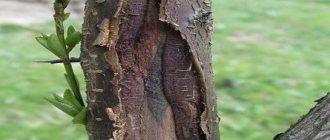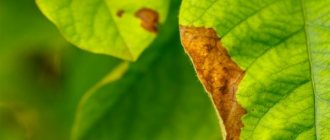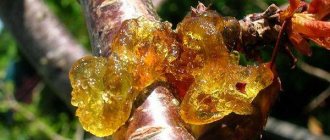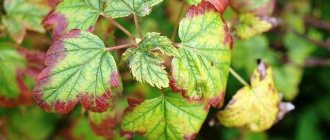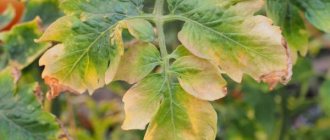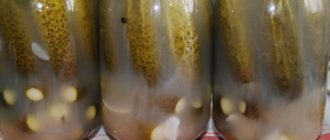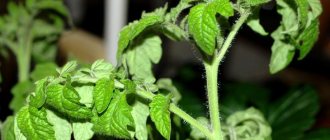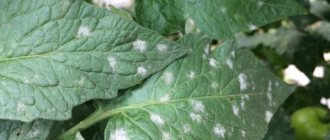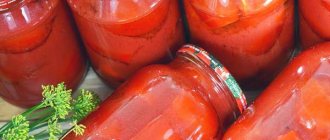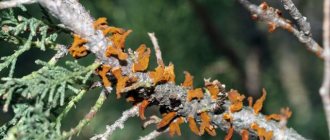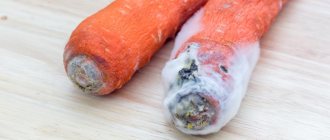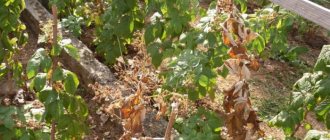If a cherry tree cracks, you should not hope that the tree will heal the cracked area on its own, and you can ignore the problem. By ignoring the appearance of peeling bark with cracks, they lose not only one tree, but the entire garden. An untreated burst wound turns into a gateway for infections or pests, weakening the cherry's defenses. Causes: weather conditions, insects, fungi and diseases. The infected tree is treated with special chemicals or folk remedies.
Why does the bark on a cherry tree burst?
Cherry trees crack most often in spring, leaving the trunk and skeletal branches exposed. When inspecting the garden, determine the depth and number of burst areas in order to select control measures. Often minor cracking heals on its own, and a tree with broken branches produces the same amount of harvest in the summer.
Stone fruit crops are prone to wood cracking; the problem occurs when there is a contrast between night and day temperatures. A non-leafy crop planted on a southern slope will react to changes with longitudinal cracks and furrows on the trunk.
Reasons for a broken cherry tree stem related to violations of agricultural practices:
- excessive penetration of seedlings into the soil during planting;
- The bark does not have time to grow against the background of the rapid growth of wood;
- cherries are planted in a humid area;
- close occurrence of groundwater;
- excessive application of nitrogen fertilizers;
- mistakes when pruning skeletal branches.
Gardeners recommend carefully inspecting the trunk and branches of the cherry tree for the presence of dead tissue and the appearance of burst areas with necrosis. It is enough to cut off the edges of cracks with burst bark with a sharp tool to get a detailed look at the damage:
- An even, white-green cut is a sign of healthy wood and does not require control measures.
- Patches of brown wood are considered a sign that the cells are filled with gum, the beginning of the dying process.
Emergency measures prevent the process of bursting and the appearance of cracks on the trunk, stop the development of rosette, chlorosis or small leaves.
Important! Cherry bark is damaged by hornets, wasps and other insects.
Exposure to weather conditions
The cause of cracking of the bark on cherries can be changes in air temperature at night and during the day. The phenomenon of bursting areas on the surface of the trunks is typical for winter sunny days. The trunk of the cherry tree in February and early March warms up to 20 degrees, and the air temperature remains at sub-zero levels. In the wood cells, the process of liquefaction of juices is activated, which freeze with the onset of night. Red-brown burns, turning into cracks with burst edges, are located on the south-eastern part of the trunk.
One of the accompanying reasons for the bursting of a cherry tree trunk is the lack of preparation for the frosty period. The gardener did not take enough measures to protect against frost damage; the tree remained unprepared for winter:
- fertilizing with nitrogen fertilizers in the second half of summer;
- late moisture-charging irrigation;
- lack of watering during the growing season;
- untimely or severe pruning.
Cherry responds to reduced daylight hours by slowing down life processes that begin in the upper parts of the shoots and end in the area of the root system. Violations during the period of preparation for frosts cause immature or burst bark with cracks and the appearance of frost holes.
Influence of pests
On a cherry tree, the bark may peel off due to insect activity. Pests eat wood, make tunnels or make nests under the bark, which leads to the formation of deep cracks and reduced frost resistance.
One of the common pests that cause cracks in cherries, the subcortical leafroller is a golden-brown butterfly that lays eggs under the bark of stone fruit trees. The hatched dirty white caterpillars chew through the wood, causing increased release of gum from the cracks of small wounds in the burst bark. They learn about the activity of the leaf roller by characteristic lumps of brownish-rusty excrement, shrouded in cobwebs.
The brown fruit mite is a reddish-brown pest that lays eggs on the branches of garden crops. Due to the abundance of eggs, the cherry seems to be covered with a red coating. The danger comes from larvae that damage leaves and buds, which leads to inhibition of branch growth and cracking of the main trunk.
The bark beetle is detected by oval holes on the trunk with gum deposits. Empty passages indicate penetration into the deeper layers and the emergence of a new generation. The last stage is considered to be the peeling or bursting surface of the cherry tree, broken off thin branches with holes at the breaking point.
Pests more often attack weakened trees, and timely preventive measures minimize the chances of insect attacks. Elementary whitewashing before winter will save cherries from cracking and bursting of wood, and digging up tree trunk circles with spraying with chemicals or folk remedies will prevent attacks by bark beetles, ticks, butterflies or caterpillars.
Diseases
A cherry surface bursting with cracks may turn out to be an infectious or non-infectious disease. It is a mistake to consider cracking of the trunk an aesthetic problem. Through open wounds, infection occurs, leading to the death of the crop.
Root causes of cracks or broken trunks:
- develop against the background of clusterosporiosis or moniliosis;
- exceeding the norm of nitrogen fertilizers;
- high soil acidity;
- excess moisture in the soil;
- due to sunburn and frost damage.
Important! You can protect against infected cherries with a burst and cracked trunk from entering the garden by purchasing a healthy seedling from a trusted nursery.
The false fungus grows from a crack in the lower part of the trunk, filling the cavities with white rot. The tinder fungus is a yellowish-brown growth. Fungal spores infect the surface in areas of frost damage, pest activity, and traces of mechanical impact. The trunk of a cracked cherry tree breaks due to gusts of wind, as the wood softens.
The sulfur-yellow tinder fungus develops in the cracks of the burst surface of the cherry, filling the core of the trunk with brown rot. Wood loses strength and falls apart. The formation is a dirty orange mushroom with wavy edges.
Attention! Bacterial canker causes the cracked surface on the cherry trunk to peel off. Infection occurs through mechanical cuts on the branches.
Gum disease or gommosis is considered a non-infectious disease of cherries. It is characterized by the leakage of gum from a burst trunk without signs of necrosis. Gum is a sweetish, viscous liquid that is a product of the breakdown of wood cell membranes. The consequence is the drying out of individual branches with burst bark, followed by the death of the tree.
Factors for outbreaks of cherry gomosis:
- damage by parasites that secrete decay products;
- mechanical injuries to the trunk;
- discrepancy between the scion and the rootstock;
- waterlogging of soil or air;
- insufficient watering.
Preventive measures to prevent cherries from cracking
Having figured out why cracks may appear on a tree trunk, it is worth preventing these phenomena in advance. Prevention is considered the process of furrowing. This event is mainly held at the end of spring, beginning of summer (May-June). Gardeners take a specially disinfected garden knife and make cuts longitudinally on the tree trunk on the north side. You need to cut not all the way through, but after a short interval. For the first time, the furrowing procedure is carried out in the fifth year after planting a young cherry seedling. The next time the procedure is carried out after a 5-year period.
If garden cherries are cracking on the site, you should carefully consider measures to prevent various tree diseases. In the case where the disease has affected a small area of the bark, it is quite possible to prevent the death of the plant by cleaning the affected area and treating it with special preparations. This prevents the death of not only one plant, but the entire garden.
Treatment of burst bark on a cherry tree
If it is too late to carry out preventive measures, they begin to treat the cracked cherry trunk. Work is carried out at any time, except during the growing season, so that the juices do not spread the infection throughout the crop.
Gardener's note:
- Using a sharp, disinfected blade, cut off the affected, burst areas with cracked edges down to living tissue. Removed formations with light rims indicate minimal infection; dark areas suggest the use of radical measures.
- According to the instructions, any copper-containing preparation is dissolved, the trunk is sprayed, special attention is paid to bursting or peeling bark.
- For cracks with pronounced areas of necrosis, strong fungicides such as nitrophen are used for treatment. The drug disinfects even neglected areas and does not damage healthy tissue.
- All that remains is to cover up the cracks and broken areas with garden varnish made from natural ingredients. It is better to abandon products based on petroleum products, and use products made from beeswax, fungicides and conifer resin.
After the procedure, the cherries are wrapped with a piece of burlap and secured with wire. They continue to install traps against insect pests and spray as needed against fungal infections.
Drugs
Before treating peeling bark on cherries, treat the surface with an ash-soap solution. When choosing chemicals for disinfection, evaluate the benefits of use against cracks and burst bark:
- the effect occurs after two hours;
- the effect lasts three days;
- the components of the product disintegrate after a week;
- dissolves without sediment in water;
- penetrate deep into the cortex.
Preventive spraying is carried out when the buds are swollen, but before the buds open. According to the instructions, a concentrated solution is used to treat the bursting surface with cracks and forks between the branches to prevent the development of diseases.
Chemicals to protect cherries from cracking:
- blue spraying with Bordeaux mixture is an indispensable assistant for the gardener in the fight against cracks in garden crops;
- treatment with copper sulfate solution stops fungal infections;
- using iron sulfate, they strengthen the cambium cells and prevent the appearance of bursting and cracked surfaces on the trunk;
- drug No. 30 - an effective method against pests;
- They are treated against insects with urea or urea and at the same time fertilized.
The universal use of copper-containing preparations (Ordan, HOM, Kurzat, Abiga-Pik) allows you to heal deep cracks and burst areas on cherries and disinfect the orchard.
Folk remedies
The burst surface of cracked cherries after cleaning and disinfection, instead of garden varnish, can be lubricated with mullein and clay in equal parts. Apply the prepared mixture to the peeling branches, securing with a gauze bandage.
The disadvantage is that it is washed off after rain, which requires repeating the procedure. Clay also absorbs cherry juices necessary for normal life support, so you will have to periodically moisten the area with water.
Crushed sorrel leaves are placed on exposed, burst frost holes with cracks, wrapped on top with polyethylene or a piece of burlap. Every month the layer of green medicine is renewed, first cutting off the blackened rims of the cracks of the burst surface with a sharp knife.
What is required to treat a tree?
When a crack appears or the bark breaks on a cherry tree, what needs to be done is to protect the tree from cracks in any period except the growing season. Because the infection will spread throughout the plant along with the juice. First of all, be sure to cut off the dead cherry bark to a white-green color with a knife or hacksaw. You need to clean the wound very well, because... Fungi may again appear under the damaged area. Then disinfect the cleaned wound with a product (1% or 3% copper sulfate, Bordeaux mixture). Dilute from 100 to 300 ml of the substance in 10 liters of water. Treat the crack well.
If it is not possible to thoroughly clean the wound, and areas of necrosis remain, then a strong fungicide (nitrafen solution) must be used for treatment. The drug disinfects damaged areas and does not affect healthy plant tissue. You need to be careful when processing. After disinfection, apply garden putty (garden pitch) to the broken area of bark.
Advice!
It is not recommended to take garden pitch, which consists of petroleum products (gasoline fractions, kerosene and others).
You can buy putty or make it yourself. To prepare, melt the ingredients in a water bath, stir in the ratio (1:1½:2:1):
- beeswax;
- linseed oil;
- resin (spruce, pine);
- turpentine.
To treat wounds, you can use an old natural recipe, the ratio (4:2:2:¼):
- manure;
- chalk (dry lime);
- wood ash;
- sand.
Consequences of cracking
Minor cracks in the cherry tree will heal without intervention from the gardener. Even a small wound in wood will turn into a haven for pathogens of fungal diseases, which will result in a decrease in fruiting, drying out of branches or the death of cherries.
Frost damage leads to tissue death or necrosis of cherries. Visually, the cherry tree continues to develop, but the bark begins to burst, crack, and peel off. The darkened areas are initially small in area, but gradually occupy the entire surface of the trunk, becoming the cause of crop loss.
Advice! If cracks or broken surfaces appear on the trunk, you should immediately use a metal brush to clean the areas down to healthy tissue, and cut off the broken branches with a hacksaw. If there remains a focus of infection with harmful bacteria, then soon the cherry tissue will be completely affected by the infection.
Cherry cracks: bark, trunk, fruits, causes and treatment - Fertility
Why? 5 reasons
- Incorrect trunk cover.
For the winter, fruit trees older than 3 years are painted with whitewash to protect them from frost and rodents. And young trees are covered with various materials: burlap, lutrasil, spandbond, nylon. When roofing felt or other dark material is used for this, this is where problems arise. The spring sun heats the roofing material, and this causes the cambium to awaken in the bark. Low temperatures at night stop this process. Such changes can destroy the cambium, as a result of which the bark of apple trees begins to burst and peel off. - Sudden changes in soil moisture.
After a long drought, you should not immediately water the trees abundantly; it is better to do it gradually. - Sharp temperature fluctuations that often occur in the spring (warm weather abruptly gives way to frost).
- Frostbites and sunburn. Whitewashing fruit trees in late autumn (with lime or water-based paint) helps prevent them.
- Bark beetle The pest can be found under peeling bark. The bark beetle also leaves traces after its meal in the form of sawdust.
What to do?
Damage to the bark, wounds and cracks in themselves do not pose a danger. The problem is that pathogens of dangerous diseases (black cancer, anthracnose and others) like to live in them. And then the troubles grow like a snowball: the damaged bark bursts, pathogens penetrate the crack, the bark peels off and dies, and over time, without the bark, the tree dies.
Cracks
The gardener’s task is to treat the crack in a timely manner, and it will heal over time. If the bark of a tree breaks, the crack is disinfected with a weak solution of potassium permanganate, hydrogen peroxide or brilliant green. Then they cover it with garden varnish. You can treat the bark with clay mash (clay and mullein) and wrap it in burlap (but not necessary).
Frostbites and burns
If the bark has suffered frost damage or sunburn, cracks may not form. At first, pinkish spots can be seen on the bark. Then the bark gradually dies off, which creates favorable conditions for the occurrence of fungal diseases. Eventually the bark peels off and dies.
If the bark of a tree peels off, without wasting time, you need to remove the damaged bark and strip it back to healthy wood. The wound is disinfected with brilliant green or peroxide. And after it dries, apply oil paint on natural drying oil. The treated wound becomes overgrown with bark over time. Instead of paint, you can also use garden varnish.
All these troubles can be avoided if you take care of the trees: cover them in time, protect them from pests, frost and sun.
Health to you and your garden!
- Severe frosts in winter.
- Unbalanced diet.
It is primarily the southern varieties that are not adapted to our climate that suffer from frost. Do not plant southern varieties (Rostov, Krasnodar, Stavropol) that are not zoned in your zone in your dacha, so as not to have problems later.
And if you do plant them, use the highest agricultural techniques for them: balanced nutrition, regular watering, proper pruning, preparation for overwintering (mulching, protecting the root system, whitewashing the trunks and tying light material on the trunks of young trees, pre-winter watering).
Agrotechnical anomalies were added to the weather anomalies. - nutritional imbalance. Many amateur gardeners overestimate the doses of nitrogen fertilizers and do not comply with the timing of their application. Only urea (urea) is considered nitrogen. But they continue to add so-called green fertilizers (infusion of grass) or diluted bird droppings, rich in nitrogen, to the soil throughout the summer.
In summer and early autumn, complex fertilizers with a minimum nitrogen content (no more than 5 percent) are needed. The main components of fertilizing at this time are phosphorus (superphosphate) and potassium (sulfate) with the addition of microelements that the plant lacks.
Such cracks appeared on a young tree after a frosty winter.
Unbalanced nutrition negatively affects the ripening of wood and core. They are the ones who most often suffer in the frosty winter. As a result, the conducting vascular system is disrupted, and the tree does not receive the necessary nutrition and, as a result, cracks on tree trunks.
Stem pests
Stem pests pose a great danger to our trees:
- fruit sapwood (apple and plum bark beetle)
- wrinkled sapwood
- western bark beetle
- woodworm
- glassware
- rodents.
Sapwood beetles
In May, sapwood beetles gnaw round holes in the bark, females make oblong passages under the bark, and their larvae gnaw out transverse passages. As a result, sap flow is disrupted and the tree becomes sick. In trees heavily affected by sapwood, not only the bark cracks, but entire branches dry out.
Control measures. Plants can be protected from sapwood by good care, which promotes better growth and development of the tree. Immediately after flowering, spray with fufanon or kemifos, thoroughly moistening the branches and trunks with an insecticide solution. Repeated treatment - after 16-18 days.
Prevention of cracks
Preventive measures are aimed at reducing the risk of infection of cherries through cracks. Following simple tips will help prevent the appearance of bursting boles with cracks:
- The choice for planting self-fertile, zoned cherry varieties that are resistant to temperature changes and recurrent frosts.
- Compliance with planting rules is the key to a healthy tree. The cherry grafting site is raised above the ground level, leaving enough space to form a tree trunk circle.
- Cherries grow successfully only on neutral soils that are limed.
- To prevent frost damage, the trunk and skeletal branches of the cherry tree are whitened in autumn and early spring; after the first leaves appear, the procedure is impractical.
- They are tied with bundles of straw, spruce branches or spunbond.
Experienced gardeners furrow the skeletal branches and trunks of cherry trees to avoid cracks and bursting of the surface. The operation is performed on 6-year-old crops, making shallow dotted furrows at intervals of several centimeters. The wounds heal quickly, the wood does not tear the tree as it grows, and the cherry tree rapidly increases in size. For additional tips on preventing and combating burst cherry bark, see the video below.
Why do the cherry trunk and berries crack?
In addition, cherry bark also suffers from sunburn. The most dangerous time for a tree is the beginning of spring, when there are still no leaves under which to hide its trunk, and the sun's rays heat up the dark bark quite strongly. As a result, a cracked bark appears that simply cannot withstand such a load. Therefore, it is not surprising if in early spring the trunk of a cherry tree bursts or the bark cracks. The following cherries are at risk:
- growing in moist soil;
- cut incorrectly or too short;
- planted too deep in the ground;
- improperly fed with nitrogen or organic fertilizers.
Cracking of cherry bark is a common phenomenon, occurring due to sudden temperature changes. If during the day the bark is heated by sunlight, and in the evening the temperature outside is below zero, this will lead to a violation of the integrity of the top layer of wood.
In the spring, when there is sharp solar activity, the tree's trunk and skeletal branches burst. During this period, the plant is just entering the growing season, so there are no leaves on it. The top layer of wood heats up and, unable to withstand the load, cracks. There is a risk of sunburn.
Most often cherries crack:
- if the tree is grown in a humid climate;
- if the gardener trimmed the branches incorrectly;
- when planting deep;
- with improper feeding.
Various diseases and pests also lead to cracks. Among the diseases, the most dangerous are monoliosis and clasterosporiasis, and among the pests - bark beetles.
- Disinfect a garden knife with an alcohol-containing solution.
- Make 2-3 longitudinal cuts on the tree trunk on the north side.
- Make 2-3 cuts, moving the knife blade a few centimeters to the side.
All cuts made should be at a large distance from each other. This procedure will not threaten the health of the plant, and the bark will not peel off. This method is used once every 5 years. The first procedure is carried out only 4 years after planting.
Possible reasons
To prevent the appearance of cracks in cherry fruits, it is necessary to provide the trees with uniform moisture. The easiest way to do this is with a drip irrigation device.
You can also use the following recommendations:
- In the spring, be careful with watering and begin to moisten abundantly only in May, when the leaf mass is growing, but only in dry weather.
- Regular moistening is especially important for cherries at the beginning of flowering and after, during fruit growth. When the berries begin to ripen, watering can be slightly reduced.
- In the second half of summer, the amount of moisture is not so significant, but it is important to thoroughly water the cherry trees before winter when the first autumn frosts occur.
- Selecting and properly planting a suitable cherry variety will also help cope with this problem.
- Fruits of such varieties as Summit, Lapens, Yaroslavna, Valeria have denser pulp, thick skin and are not so susceptible to cracking.
There are a number of drugs, the use of which can reduce cracking of cherry berries. They cover the fruits with a transparent film, which increases skin elasticity and prevents moisture loss.
The simplest remedy is to spray the trees with a solution of calcium chloride. Its only disadvantage is that the fruits must be washed with water before consumption or sale to remove salt deposits.
We suggest you familiarize yourself with How to properly fry delicious potatoes || Types of fried potatoes
The preparation “Vodosbor” (from pine resin) is of exclusively natural origin.
Many of the listed remedies not only protect cherry fruits from cracking, but also reduce ripening time and increase the size of the fruit and its sugar content.
Every gardener knows that cherries need to be carefully cared for. If it does not receive proper care, then problems with the structure of the trunk begin. To understand what to do if the bark of a cherry tree has burst, you need to determine the true cause of the problem.
Cracks in cherry bark appear for several reasons:
- rodents. Field mice often feed on tree bark, which leads to the death of the plant.
- a large amount of moisture. If the bark of a cherry tree is cracked, pay attention to the quality of watering. This fruit tree needs moisture, but its amount should be moderate. As soon as you overwater the plant, the trunk bursts, which can lead to the death of the cherry tree or growth. The optimal amount of water per plant is 10–15 liters. The interval between watering is 10 days.
- sun burns. At the end of March, cracks appear on the cherry tree trunk. This is due to the fact that the plant does not yet have foliage to protect it from excess sun. You need to choose the right planting location so that the tree does not get direct sunlight and the trunk does not crack.
- diseases. This is usually associated with fungal infections that appear due to poor quality care.
Diseases
Cherries are susceptible to various diseases, which can cause cracking of the cherry bark. These are false tinder fungus, perforated spot, moniliosis, etc. They need to be dealt with in a timely manner.
False tinder
This disease manifests itself in the formation of small growths on the tree trunk.
As soon as the tinder fungus infects the protective layer of the plant, it becomes soft and the bark cracks.
If the fruit tree is completely covered with such growths, then there is nothing left to do but get rid of the plant. If the growths appear at a great distance from each other, then copper sulfate will help. Dilute 20 g per 5 liters of water. Spray the tree with it every ten days until the growths disappear.
With this disease, small spots form on the leaves, which turn into holes. Then the tree bark cracks and collapses. The disease can also spread to the branches. All this leads to the fact that the cherry tree does not bear fruit and dies.
The following procedures will help cure cherries:
- removal of all affected branches;
- weekly treatment of the plant with Bordeaux mixture (30 g per 10 liters of water);
- after trimming the branches, it is necessary to treat them with garden varnish;
- Burn all fallen leaves immediately; if bacteria from them get onto the soil, the entire garden will become infected.
Moniliosis
If the wood is slightly cracked, then fungal bacteria actively develop in this fracture. As a preventative measure, it is recommended to treat trees annually with a solution of copper sulfate (20 g per 10 liters of water) and trim dry and damaged branches. This disease manifests itself in the appearance of sunburns on the surface of the bark, similar to sunburn. These spots have a grayish tint.
If the bark has burst and you notice signs of moniliosis, then the treatment process is as follows:
- the affected areas must be removed immediately, and as a preventive measure, the healthy part of the tree must be trimmed by 10 cm;
- burn all cut branches outside the garden;
- treat weekly with iron sulfate (30 g per 10 liters of water);
- Treat cutting areas of diseased branches with garden varnish.
Coccomycosis
The main symptom of this disease is brown spots on the leaf blades. Due to coccomycosis, they dry out and the bark cracks.
To prevent coccomycosis, the following measures are taken:
- before flowering, trees are treated with a solution of copper sulfate (20 g per 10 liters of water);
- as soon as flowering ends, treat with Khomus solution (30 g per 10 liters of water);
- after 20 days, treatment with Khomus is carried out again.
Cherries are affected not only by diseases, but also by pests. Among them are ticks and Californian bark beetles. They make nests inside the trunk, which causes the death of the entire tree.
The bark on cherries delaminates for several reasons. First, the gardener must inspect the affected area and determine why the bark is cracking. Only after this can you begin to treat the plant. For prevention, you need to follow all the rules of care. If you properly care for a tree, the risk of it being affected by parasites and diseases will be significantly reduced.
Climate influence
It is important to observe the tree, because As a result of temperature fluctuations, the crack may increase. New damage should be treated promptly. After some time, a seal (callus) forms around the crack, which will prevent the appearance of new breaks.
If the damage is too severe, bridge grafting will help save the tree by restoring sap flow.
Cherry trees whose bark has burst need special attention and timely feeding with complex fertilizers at the beginning of summer.
If cracks in the trees in your garden have become widespread, it is best to contact a phytopathologist - a doctor who treats plants.
Climate influence
In spring, you can observe that the bark of the trees in the garden turns black and cracks. The reasons for this can be varied. Usually, in small quantities, such stains do not pose a danger to the health of the tree. It can recover completely and produce a large harvest. But if the entire area of the tree is damaged, then the plant often cannot cope with the disease and dries out.
Why did the bark burst on the cherry tree? It must be said that cracked tree bark does not always indicate a disease affecting garden crops. This can happen due to cold or extreme heat.
Even in temperate climates not subject to severe frosts, the bark of stone fruit trees, including cherries, cracks. This is considered normal. For example, at night there was severe frost, in the morning the sun's rays heat the trunk, and in the evening the air temperature again dropped significantly.
All these fluctuations in temperature conditions lead to the fact that the trees cannot withstand and crack.
The color of the wood also indicates damage. This can be determined by transverse and longitudinal sections. If the cherry is healthy, then the cut bark will be white. Damage is indicated by a brown tint to the wood. This means that the conductive vessels are clogged with gum, chlorosis, milky shine, small leaves or rosettes develop. These diseases need to be treated immediately.
- Incorrectly performed autumn pruning, as well as subsequent processing of the cuts.
- Lack of systemic watering. Trees need comprehensive hydration - through the root and above-ground parts.
- Branches breaking off in the wind can cause wounds.
- Diseases of bark and wood - lichens, necrosis, scab, etc.
- Frost damage is cracking of the bark due to sudden changes in temperature in autumn or early spring.
Why do cherries crack?
It is possible to prevent cracking of fruits by choosing resistant varieties of cherries, as well as strict adherence to agricultural practices. Cracks and bursting fruits are not considered a sign of a serious disease. Gardeners have noted the varieties “Summit”, “Yaroslavna”, “Regina” and “Valeria”, which produce a harvest of large, one-sized fruits without cracks or damage.
Exposure to weather conditions
Cracking and bursting of cherry berries is most often observed when the dry period is replaced by heavy rains. Frequent fogs or heavy dew also provoke spoilage of fruits.
The same phenomenon occurs when a gardener has not watered a crop for a long time, after which he decides to replenish the moisture deficit. Due to excessive water intake, the fruits burst and become covered with deep cracks, often down to the pit.
Influence of pests
One of the dangerous pests of cherries is the cherry fly, which lays eggs in unripe berries. Due to the activity of the larvae, the fruits become dented, soften, burst, and the skin becomes thin and cracks.
Deep digging of row spacing and treatment of the crown and trunk circle of cherries with chemicals like Actellica help reduce the number. Spraying is carried out during the period of insect flight, which is detected using glue traps. It is enough to apply a layer of long-drying glue to sheets of cardboard, then hang it on neighboring trees. It's time to start processing if more than 12 flies are caught in the trap.
Diseases
During the flowering period, cherry trees become infected with scab, which is caused by harmful bacteria and pathogenic fungi. Wet weather provokes the spread of the disease, affecting garden crops.
The disease manifests itself as brownish spots on the leaf blades, green berries dry out and fall off, ripe fruits begin to crack and burst. Spraying cherry trunks with Bordeaux mixture three times during the growing season will prevent the development of scab.
What to do if the cherry cracks?
To prevent the bark on the tree trunk from cracking, it should be protected from direct sunlight. It is necessary to whiten garden plantings in autumn. To prevent cherries from cracking after frosty days, gardeners wrap the trunks with artificial insulating material. It will protect against the negative influence of the environment, including frost and sunlight. The material can also protect against rodents (hares, mice and some other animals), which like to feed on young tree bark in winter.
Timely measures will help protect the plants and the bark will not begin to crack. But if this does happen, a variety of treatment methods should be carried out to prevent the death of garden crops.
How to treat cracks in bark
If the bark on your cherry tree does burst, you should disinfect the wound by treating it with 1% copper sulfate or Bordeaux mixture, and then cover it with garden varnish.
It is important to observe the tree, because As a result of temperature fluctuations, the crack may increase. New damage should be treated promptly. After some time, a seal (callus) forms around the crack, which will prevent the appearance of new breaks.
If the damage is too severe, bridge grafting will help save the tree by restoring sap flow.
Cherry trees whose bark has burst need special attention and timely feeding with complex fertilizers at the beginning of summer.
If cracks in the trees in your garden have become widespread, it is best to contact a phytopathologist - a doctor who treats plants.
Category : cherries. Asks : Nadya Prokhorova. The essence of the question : you noticed a cracked trunk on a cherry tree, why?
Good afternoon. Yesterday we were upset because we saw that the trunk of the cherry tree had cracked. And this caused the bark to crack. What to do in this situation? How to save cherries? She is still bearing fruit. Juice flows from the crack. I'm very sorry for the tree.
Prevention of cracking
You may be interested in: Rules for pruning cherries and diagrams by age How to properly care for cherries in the autumn How to plant cherries correctly
As a preventive measure it is recommended:
- prepare the tree for wintering;
- protect the trunk from sunlight;
- dig up the trunk circle in the fall;
- fertilize;
- carry out sanitary pruning;
- carry out preventive spraying.
Damaged branches need to be removed regularly. Watering and fertilizing should be moderate.
Preventive actions
Constant monitoring of the condition of the bark and timely treatment of affected and diseased trees will help prevent cracks from appearing in garden crops. First of all, it is necessary to regularly inspect the entire garden for pests or diseases. It is important to carry out preventive treatment every spring, then you will not have to treat the trees.
- In the fall, surround the trunk with metal mesh to protect it from rodents.
- Before winter, dig up the tree trunk circle.
- Prevent sunburn by whitening the tree trunk and skeletal branches in autumn.
- Get rid of damaged, dried branches in a timely manner.
- In the spring, it is necessary to spray the garden with fungicidal and insecticidal preparations for preventive purposes.
Treatment of damaged wood
If the bark of a fruit tree is cracked, it is important to help the cherry tree recover. Problem areas should be treated with an absorbent or antibacterial substance, and you can also use products such as:
If you managed to buy artificial bark, such a product will last a long time and be effective. It is firmly attached to the wood without losing its properties in any weather conditions.
The control of diseases and pests is limited to the use of chemicals (fungicides, etc.). For fungal diseases, the affected areas are removed and burned. The effectiveness of treatment depends on the degree of damage to the plant.
Problems and diseases of cherry bark and their treatment
Cracks in the bark on the trunk or branches of a cherry tree are initially only an aesthetic problem. But if left without proper attention, the consequences can be more than serious.
When the bark and trunk of a cherry tree crack, infectious diseases can develop:
- bacterial cancer;
- false tinder fungus;
- sulfur-yellow tinder fungus.
Gum therapy is non-infectious.
When an infection gets into a crack in a cherry tree, diseases of the first group develop, which are very difficult or almost impossible to fight. Therefore, prevention and timely treatment of wounds in cherry trees is very important.
When gum drips on the trunks and branches of cherries, a sticky translucent mass is released in various places - gum, which hardens in the form of glassy drops.
Signs of the disease are especially active:
- on acidic or waterlogged soils;
- after using high doses of fertilizers, especially nitrogen;
- when cherries are weakened by infectious diseases such as monoliosis, clasterosporiasis;
- after damage to the cherry bark as a result of frost damage or sunburn.
In fact, gum production is a tree’s reaction to any damage or weakening.
Why do the bark and trunk of cherry trees crack?
The primary source of all diseases of the cherry bark and trunk is the appearance of cracks, so first of all it is necessary to understand in detail the reasons leading to this phenomenon.
- As mentioned earlier, one of the main reasons why cherry bark cracks is excess soil moisture. As a result, the young bark begins to grow rapidly, and the old, not so elastic, cannot withstand such pressure and cracks.
- An equally common cause is exposure to contrasting temperatures. It is especially dangerous for cherry trees in early spring, when the sun begins to heat up very intensely. Scientists measured the temperature on the southern sunny side of a tree trunk in February - March: it reached 15...20 °C. At the same moment, the ambient air temperature in the shade was -15...-18 °C. In the sun, tree sap liquefies under the influence of heat and then freezes - as a result, cracks appear on the bark.
- No less dangerous are sunburns, which look like brown or reddish spots on the branches or trunks of cherries. In these places, under the influence of sunlight, the process of photosynthesis begins, although not as active as in the leaves. But the substances formed as a result of its activity have nowhere to go: in winter there are no growth points, and energy can be spent on the development of all kinds of infections that remain dormant in the tree.
- Another reason for the appearance of gum and, as a consequence, the formation of cracks in cherries are mistakes made when pruning the tree (untimely or excessive pruning).
- Improper planting of cherries, primarily excessive deepening of its root collar, can also lead to cracking of the tree bark.
- In addition, all stone fruit trees, and cherries in particular, have a predisposition to the appearance of cracks on the trunk due to the growth characteristics of standard cells.
Therefore, it is very important not to overdo it with the application of nitrogen-containing mineral and organic fertilizers, which affect the growth and development of plants.
What to do if the bark on a cherry tree bursts
First, you should optimize the watering regime and try not to over-moisten the soil in which the cherries grow.
Unfortunately, humans cannot cope with constant heavy rains. Therefore, the question arises: what to do when the cherry tree trunk has already burst.
- Whatever the size of the damage to the bark on the trunk, it must be cleaned with a sharp instrument to the living tissue and slightly dried.
- Afterwards, treat with any 1–3% solution containing copper sulfate (Khom, Oksihom, Bordeaux mixture). To do this, dilute 100–300 ml of solution in 10 liters of water. It is necessary to spray so that the mixture does not flow off the bark, but settles in the crack.
It is good if the edges of the wound on the bark are light in color: this means that the damage to the trunk is caused by purely physiological reasons and the infection has not yet occurred.
If the edges of the bark are brown or it is impossible to completely clean the wound (for example, due to its inconvenient location), then more intensive treatment will be required. In this case, you can use a nitrophen solution. This is a fairly serious fungicidal drug, capable of destroying all infection on dead wood, while it practically does not penetrate into living tissue. But special precautions should be taken when working with it.
After treating with fungicides, the crack in the tree should be closed with one of the suitable putties. The easiest way is to use garden varnish. But not every varnish promotes good healing of wounds on a tree. Before using (purchasing), you need to study the composition of this product.
Treatment for cracked bark
Damaged bark cannot fully perform the functions assigned to it, so you need to help the tree. The simplest way to rid cherries of cracks in the bark is to cover them with a mixture of clay and mullein. The product helps the tree quite well, but has some disadvantages:
- Nowadays, people are less and less likely to have cows, so it is very difficult to quickly find manure.
- Not a particularly pleasant way to prepare putty.
- Short lifespan of the putty. This product will wash away the first good rain. You can, of course, extend the life of the putty by wrapping the treated area with a bandage on top, but this is an extra hassle that not everyone will agree to.
Another negative side is that clay is an excellent absorbent. After drying, this putty will absorb juice from the bark, which is intended for cherries. You can, of course, periodically water the area of bark treated with putty in hot weather, but this is a waste of time.
Clean cracks in the bark at any time, except during the growing season, since the movement of sap will spread the disease throughout the tree. Next, you need to wait until the crack area dries. After this, you can treat it with an antifungal drug and apply a special putty on top. There are not as many of them as we would like, but there are still plenty to choose from:
- Garden varieties from different manufacturers. Some gardeners speak negatively about it, claiming that the varnish loses its properties after a year, and after that it does more harm than good. So whether to use this remedy to treat cracks in cherries or not, you will have to decide for yourself.
- Artificial bark. This remedy for ridding trees of cracks appeared relatively recently. It can be purchased at almost every gardening store.
